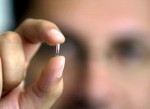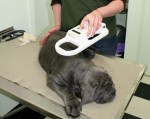WHY YOUR PET NEEDS A MICROCHIP
All your microchip questions answered
What is a microchip?
 It’s a tiny electronic device about the size of a grain of rice, encased in a glass cylinder. The chip’s integrated circuit uses passive RFID (Radio Frequency Identification) technology to store a unique ID number. There are no batteries, the chip is activated by radiowaves emitted by a hand-held scanner, similar to a barcode scanner, passed over the implant area. Once activated the microchip transmits the identification number to the scanner, which displays the number on a computer screen.
It’s a tiny electronic device about the size of a grain of rice, encased in a glass cylinder. The chip’s integrated circuit uses passive RFID (Radio Frequency Identification) technology to store a unique ID number. There are no batteries, the chip is activated by radiowaves emitted by a hand-held scanner, similar to a barcode scanner, passed over the implant area. Once activated the microchip transmits the identification number to the scanner, which displays the number on a computer screen.
How does it help me find my lost pet?
When a lost or stray animal is found and taken to a shelter or a veterinary clinic, the first thing they will do is to scan the animal for a microchip. If they find one they can quickly contact the animal’s owner and arrange to have the animal returned.  As long as the owner has kept their contact details up to date on the registry database the microchips can be used to locate a pet’s family anywhere in the world.
As long as the owner has kept their contact details up to date on the registry database the microchips can be used to locate a pet’s family anywhere in the world.
Microchips are also invaluable in ownership disputes. If your pure bred dog or cat is stolen and subsequently located, a scan of the microchip will quickly establish that you are the legal owner.
My pet has an ear tattoo. Is this the same as a microchip?
No. An ear tattoo indicates only that your pet has been desexed. It cannot be used to locate the owner.
Does my pet still need collar tags after it’s microchipped?
Absolutely! ID tags on your pet’s collar with up to date details of your name and address are still important. But tags and collars can fall off, or be taken off. The microchip is permanent and tamper proof and always there as a fail safe backup to any external identification tags.
Is microchipping expensive?
No, it’s remarkably cheap. The one-off lifetime fee is kept low to encourage microchips in as many pets as possible. At Alpine Animal Doctors we currently charge $30.00 for microchipping, which covers the cost of the microchip plus database registration and a small fee for admin. We sometimes have special microchip days when the cost is further subsidised, usually down to $20. Council also have a reduced cost annual Microchip Day.
Do I have to have my pet microchipped?
In Victoria, microchipping is compulsory for all cats and dogs being registered with a council for the first time. In the Alpine Shire all dogs and cats over the age of three months are required to be registered. If you already live in the Shire and your dog or cat was born after 1 May 2007 it must be microchipped and registered with Council. If your dog or cat was born before 1 May 2007 and was first registered with Alpine Shire Council prior to that date there is currently no legal requirement for it to be microchipped, although it is strongly recommended. Having a microchipped pet means you also get a reduced annual registration fee of just $18 rather than the full rate of $54.
If you moved to the Shire after 1 May 2007 then your dog or cat must be microchipped prior to registration even if it was born before 1 May 2007. If you obtain a dog or cat from a breeder registered as a Domestic Animal Business, from a pet store or an animal shelter the supplier is required to microchip the animal before you take it home, and to ensure your details are recorded with a licensed animal registry within three days. There is no legal requirement for you to microchip a horse, pet bird or other animal.
Is microchipping only for dogs and cats?
No. Just about any animal can have a microchip implanted. We implant chips in birds, turtles, reptiles, alpaca, horses and many other animals.
How is a microchip implanted?
 It’s injected under the skin using a hypodermic needle. In dogs and cats microchips are usually inserted at the back of the neck, between the shoulder blades. Horses are microchipped on the left side of the neck, half the distance between the poll and withers, into the nuchal ligament. A microchip for a bird is injected into their breast muscles. Other species have their microchips implanted in various places. Getting the location correct is quite important, which is why a veterinarian with a detailed knowledge of the anatomy of many species is generally the best choice for microchipping.
It’s injected under the skin using a hypodermic needle. In dogs and cats microchips are usually inserted at the back of the neck, between the shoulder blades. Horses are microchipped on the left side of the neck, half the distance between the poll and withers, into the nuchal ligament. A microchip for a bird is injected into their breast muscles. Other species have their microchips implanted in various places. Getting the location correct is quite important, which is why a veterinarian with a detailed knowledge of the anatomy of many species is generally the best choice for microchipping.
Does it require surgery or anaesthesia?
No, it’s a simple, routine procedure little different to any other injection and takes only a few minutes. You can however also choose to have it done at the same time as other procedures such as neutering. An anaesthetic is sometimes used for birds to ensure they remain properly restrained.
Is it painful?
No more than a typical vaccination injection, although the needle is slightly larger. Most animals don’t seem to be bothered by it.
Is it safe?
The evidence overwhelmingly says yes. Some animals do have adverse reactions but these are rare. The most common problem is migration of the chip from its original implantation site. This can mostly be avoided by using an experienced implanter such as your vet. Other problems, such as failure of the microchip, hair loss, infection, swelling, and tumor formation are much rarer. To put the issue in perspective, the British Small Animal Veterinary Association (BSAVA) maintains a database of adverse reactions to microchips. Since it was started, in 1996, over 4 million animals have been microchipped and only 391 adverse reactions have been reported. Of the many millions of animals around the world who have microchips only a very, very few will ever experience any sort of adverse reaction. Rates of serious complications attributed to microchips are of the order of one in a million.
Do microchips cause cancer?
There have been claims that they do but there is little or no scientific evidence supporting those claims. There have been reports that lab mice and rats developed cancer associated with implanted microchips. However, these were rats and mice being used for cancer studies and strains known to be more likely to develop cancer. Cancerous tumours associated with microchips have been reported in only two dogs out of millions microchipped, and even in these two cases a direct causal relationship between the microchip and the tumour has never been definitively established. Every independent study has concluded that the benefits of microchipping far outweigh any potential risks but if you still have concerns you should discuss them with us or research the available scientific material for yourself. A good starting point is the AVMA’s backgrounder on Microchipping of Animals.
What information is stored on the microchip?
Only the identification number is stored on the microchip itself. This unique ID number is linked to a computer record held by a licensed pet registry. Those records contain details of the animal and its owners name, address and contact details. These are set up by the authorised implanter (your vet, Council, RSPCA etc) but you can access and update them yourself at any time via the internet or by telephone.
Can I track my pet through the microchip?
No. The microchip is not a GPS and cannot track your animal if it gets lost. There are, however, now GPS devices that can be affixed to collars or, in some cases, implanted. These can also help you locate a lost pet but they do not take the place of a microchip.
Can it store my pet’s medical records?
Currently, no. Some licensed pet registries will allow you to store medical records along with your other registration details.
What if I move house?
All of the pet registries have online facilities that allow you to enter your pet’s microchip number and check and update your records. Or, if you are not comfortable with online forms, the Alpine Animal Doctors hospital staff are happy to do any updates for you. The microchip is only as good as the records kept at the registry so it is very important that you keep them up to date.
What if I lose the microchip number?
No problem. At Alpine Animal Doctors we also securely store the microchip number with your pet’s medical records. You can also have your pet scanned to recover the number. Any Council, veterinary clinic, animal shelter or other authorised implanter can do this for you.
Do microchips ever fail?
Sometimes, yes. Like any electronic device there is the occasional chip that doesn’t activate when read by a scanner. But it’s very, very rare, the failure rate is one in tens of millions of chips.
Does a microchip really help me find my lost pet?
Yes, it does. Microchips are the single most effective way to reunite you with your lost pet. For any animal lover who recognises that they have a duty of care to their furry family members microchips are as essential as good nutrition, exercise and regular health care.

